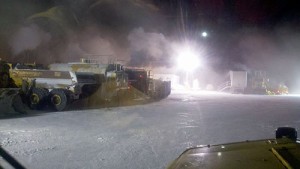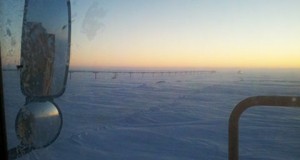
By Brenna Wiegand
For the third year, David Bayer of Silverton awaits a call – one that means kissing his wife and family goodbye and heading into Alaska’s uppermost reaches for months at a time. As a truck driver/operator for Peak Oilfield Service, Bayer builds the ice roads essential to oil exploration on Alaska’s North Slope.
Bayer, 66, knows he’ll land four miles from the Arctic Ocean, work 12 hours, seven days a week in constant darkness and extreme weather conditions, either alone in his truck or at base with the same 50-60 others. Yet he’s grateful; a little excited, even.
“It is good money, and everything you make up there, after the government gets through with it, is yours,” Bayer said. “They feed you, they house you… The only thing out of my pocket was a plane ticket out there and the clothes I bought. I’m retired, so it’s kind of nice; otherwise I would have to go to work full time.”
Drilling for oil in Alaska starts when an operator – say, BP – sends a crew of “juggies” to a remote area to perform seismic testing. If the pictures look promising, they need to get a drill rig out there to see what’s percolating.
“Now, this is half as big as a Costco,” said Jim Roberts, Peak Oilfield Service Human Resource Director. “It’s 175 feet high; it’s on wheels and weighs millions of tons and, guess what? It can’t touch the ground.”
The Alaskan tundra is a national preserve. Peak Oilfield Service moves in to build a road of ice, often 25-30 miles long and 18 feet thick in spots, wide and strong enough to transport the rig and the entourage it entails, including a 90-man camp the equivalent of a three-story apartment building – and its own power generation plant.
“We have permits to get into the natural ponds very ecologically and extract water and ice chip, which we begin spreading on the snow; David’s job is to operate the associated trucks and machinery it takes to do it,” Roberts said. “And by the way, a temperature of 20 below is considered a really nice day.”
 “I’ve been outside for as long as an hour and you’d never know it; in fact I was sweating,” Bayer said. “It can be dangerous, but I’ve never felt in danger.”
“I’ve been outside for as long as an hour and you’d never know it; in fact I was sweating,” Bayer said. “It can be dangerous, but I’ve never felt in danger.”
Bayer often drives a semi-truck and dump trailer, hauling loads of ice chip from a frozen lake and dumping it on top of a water layer. Progress is usually a mile a day with shifts around the clock, and Bayer says, “working days is the same as working nights except for that brief hour or so of dusky daylight.”
When the road’s been tested and approved about a city block’s worth of infrastructure is towed in.
“Spring comes, the ice all melts and there is not a human footprint or fingerprint on the tundra but for a single pipe – wellhead – sticking out of the ground,” Roberts said. “It’s pretty magical stuff; you’d have never known there was an operation the size of a small city happening out there in the winter.”
And this happens all over Alaska’s Kenai Peninsula and now, in North Dakota, requiring masses of truck and machinery operators from across the country.
“A lot of those guys don’t come out until the ice melts because, you know what, it pays really freakin’ good,” Roberts said.
They climb into the gargantuan trucks and head into darkness, always at Mother Nature’s mercy.
“We had a couple storms that were 60 below without the wind chill,” Bayer said. “We don’t work past 40 below but you still have to go out and check the equipment every hour because if something stops running it can be quite a process to get it going again.” In lesser storms they congregate and convoy back to camp.
“What we do is not to be confused with the reality TV show Ice Road Truckers,” Roberts said. “The ones you see on TV are a bunch of Canadian cowboys going over roads and areas that happen to be iced over.”
“Missing loved ones is the toughest adjustment for me,” Bayer said. “We can get service at the base camp in Dead Horse so I like to call home every night.”
 He’s been a trucker since Joy, his wife of 20 years, has known him. The rest of the year he helps with her business, “Auntie’s,” selling vintage items on the road, and is remodeling their home.
He’s been a trucker since Joy, his wife of 20 years, has known him. The rest of the year he helps with her business, “Auntie’s,” selling vintage items on the road, and is remodeling their home.
“It didn’t figure out to fly home in the middle of it and we decided to tough it out from the beginning,” Joy Bayer said. “It was just fine for a couple weeks and then, wow, it gets really lonesome.
“You feel so thankful he gets to go, so I don’t like to get too crabby about it,” Joy said. “It isn’t like he’s in the army; nobody’s shooting at him and it’s not a year, so you just have to pull yourself together.”